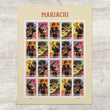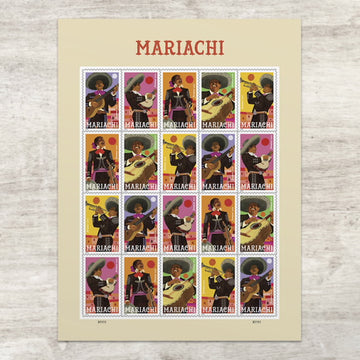Mariachi Stamps

Regular price
$23.99
Sale price
$23.99
Regular price
Mariachi Stamps
Regular price
$23.99
Sale price
$23.99
Regular price
Product description
Shipping & Return
Filled with passion, rhythm, and stories of life, love, and loss, mariachi music is an integral element of Mexican American culturethat has found fans around the world.
Each of the five new stamps features a musiclan dressed in trae de charro, the traditional outfit of marachi pertormers, playinoone of five iconic mariachi instruments: guitar, guitarron, vihuela, violin, and trumpet. The geometric shapes in the backaround oteach stamp are a nod to Mexican viages where mariachi music oricinated. The dicita ilustrations started as rouch sketches onpaper, with the textures and colors added dicitally. The artist used vibrant colors that evoke Mlexican culture and capture thebuoyant yet nostalgic feeling of mariachi music.
"Marachi" reters to severa things: to the music itself: to an individual musician or an ensemble of musicians: and. used as anadiective, to anvthing identified with the music. be it dance or costume or culture.
Though mariachi's exact origins are obscure, it appears to have bequn in western Mexico, where itinerant musicians made theirliving traveling from village to vllage to perform. The music of early mariachi included folk traditions from Spain, Mexico, and Africathat melded to create a new indigenous musical form, the son, which developed various reqional styles.While mariachi music had been in the United States for many vears. bv the 1960s, American churches. schools. and universitiesbegan to develop and sponsor mariachi programs that produced new generations of musicians and enthusiasts. lmmigrants tovarious parts of the U.S. created vibrant regional marachi cultures that widened the appeal of this traditional music to newaudiences. n addition the American marachi movement is being disseminated by first, second, and third-generation MexicanAmericans as a way of expressing ethnic pride and of staying connected to their heritage.
Mariachi bands traditionally used the round-backed guitar called the vihuela, which gives the mariachi music its rhvthmic vitality.the guitarron, which is a bass quitar; and the Mexican folk harp, the arpa. By the 1940s and 1950s. the modern urban mariachisound emered with the exoanded instrumentation inc udind vio ins and trumpers. odav. ensembes continue to boroaden the useof instruments, with some groups adding six to eight violins, two to four trumpets, an accordion, and the arpa, which had fallen outof use but has made a comeback among professional groups.
in recognition of the importance and widespread appeal of mariachi music and culture, in 2011, UNESCO added them to the list“Intangible Cultural Heritage of Humanity.”
Rafael Lopez designed the stamps and created the art. Derry Noyes art directed the projectThe Mariachi stamps are being issued as Forever@ stamps in panes of 20. These Forever stamps are always equal in value to thecurrent First-Class Mail one-ounce price.
Made in the USA.
SKUs featured on this page: 482304
Each of the five new stamps features a musiclan dressed in trae de charro, the traditional outfit of marachi pertormers, playinoone of five iconic mariachi instruments: guitar, guitarron, vihuela, violin, and trumpet. The geometric shapes in the backaround oteach stamp are a nod to Mexican viages where mariachi music oricinated. The dicita ilustrations started as rouch sketches onpaper, with the textures and colors added dicitally. The artist used vibrant colors that evoke Mlexican culture and capture thebuoyant yet nostalgic feeling of mariachi music.
"Marachi" reters to severa things: to the music itself: to an individual musician or an ensemble of musicians: and. used as anadiective, to anvthing identified with the music. be it dance or costume or culture.
Though mariachi's exact origins are obscure, it appears to have bequn in western Mexico, where itinerant musicians made theirliving traveling from village to vllage to perform. The music of early mariachi included folk traditions from Spain, Mexico, and Africathat melded to create a new indigenous musical form, the son, which developed various reqional styles.While mariachi music had been in the United States for many vears. bv the 1960s, American churches. schools. and universitiesbegan to develop and sponsor mariachi programs that produced new generations of musicians and enthusiasts. lmmigrants tovarious parts of the U.S. created vibrant regional marachi cultures that widened the appeal of this traditional music to newaudiences. n addition the American marachi movement is being disseminated by first, second, and third-generation MexicanAmericans as a way of expressing ethnic pride and of staying connected to their heritage.
Mariachi bands traditionally used the round-backed guitar called the vihuela, which gives the mariachi music its rhvthmic vitality.the guitarron, which is a bass quitar; and the Mexican folk harp, the arpa. By the 1940s and 1950s. the modern urban mariachisound emered with the exoanded instrumentation inc udind vio ins and trumpers. odav. ensembes continue to boroaden the useof instruments, with some groups adding six to eight violins, two to four trumpets, an accordion, and the arpa, which had fallen outof use but has made a comeback among professional groups.
in recognition of the importance and widespread appeal of mariachi music and culture, in 2011, UNESCO added them to the list“Intangible Cultural Heritage of Humanity.”
Rafael Lopez designed the stamps and created the art. Derry Noyes art directed the projectThe Mariachi stamps are being issued as Forever@ stamps in panes of 20. These Forever stamps are always equal in value to thecurrent First-Class Mail one-ounce price.
Made in the USA.
SKUs featured on this page: 482304
Shipping cost is based on weight. Just add products to your cart and use the Shipping Calculator to see the shipping price.
We want you to be 100% satisfied with your purchase. Items can be returned or exchanged within 30 days of delivery.







